

"Most would agree that the area between the Big Dipper and Cassiopeia is as close to a stellar void as there is in the heavens," Scotty wrote in March 1985. "If asked, I could not point out which 4th-magnitude stars are Alpha and Beta Camelopardalis, but I can turn a telescope to the star field containing 13th-magnitude Z Cam without hesitation." Scotty knew an underdog constellation even when he couldn't see it. Perhaps that's why he devoted so many words to describing the hidden treasures in this dim corridor of stars in the northern sky. Beyond its familiarity to variable-star observers, Camelopardalis was largely avoided by skywatchers of his generation. That did not keep Scotty from grabbing his telescope and visually roaming this Stella incognita. And he did not go it alone. He used his column to invite others to explore this new frontier. "Camelopardalis is a wonderful training arena," he wrote, "for those who want to sharpen their skills at finding inconspicuous targets."
amelopardalis is the absence of a constellation," wisecracked Dalmiro F.
v^Brocchi, a well-known chart maker for the American Association of Variable Star Observers. Joseph Meeks, the man who taught me to observe variable stars, considered the Celestial Giraffe “the black hole of all the constellations." In my early years I thought of venturing into this part of the sky as something akin to exploring the den of Beowulf’s dragon. But times have changed, and many of today’s deep-sky observers enthusiastically probe the star-poor regions avoided by earlier generations.
These February nights the broad expanse of Camelopardalis rides high in the sky between Auriga and Ursa Minor. Although it may look bleak to the naked eye, it offers a variety of telescopic deep-sky wonders. Some objects arc easy, and some are real tests. The most numerous deep-sky objects in Camelopardalis arc galaxies, and the most impressive of these is NGC 2403 (Figure 2.1).
It s too bad that Messier missed this spiral while hunting comets. If it had been included in his list, it would certainly be one of the better-known galaxies in the northern sky. Sky Catalogue 2000.0 lists NGC 2403 as about '/C in diameter and shining with the total light of an 8.4-magnitude star — values similar to the
Figure 2.1
NGC 2403 is a spiral galaxy with open arms, a hint of a bar, and a small central bulge. The spiral arms are bursting with star-forming regions and young supergiant stars.
famous Whirlpool Galaxy, M51. Indeed, NGC 2403 is the brightest galaxy north
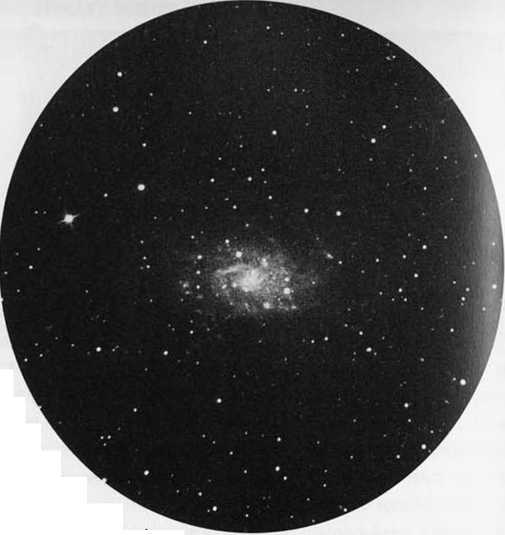
of the celestial equator that does not have a Messier number. But, like other objects of considerable area and little central condensation, it is more difficult than its listed magnitude might suggest. Because of its low surface brightness, this oblong patch is easily missed if you look for too small an object. NGC 2403 lies 1° west of 6th-magnitude 51 Camelopardalis. Curiously, the galaxy is not covered in many of the old observing handbooks, but Hans Vehrenberg includes it in his Atlas of Deep-Sky Splendors.
In his Celestial Handbook Robert Burnham Jr. notes that NGC 2403 is frequently swept up by comet hunters. I suspect that those who mistake its nature are new to the comet-hunting game, since all the veterans I know agree that comets just do not look like galaxies. The very successful 19th-century New York comet hunter William R. Brooks made a similar comment. And Leslie C.
Peltier once wrote, “To me there is a definite substantial appearance to the light emanating from a comet [unlike] the evanescent fugitive shimmer that finally reaches us from the immensely distant cluster or nebula.”
(Interestingly, Peltier included NGC 2403 in a list of galaxies for testing the suitability of telescopes for comet hunting. This is a topic worth systematic experiments by amateur astronomers. It would be particularly helpful if the experiences of a number of observers with varied equipment could be collect ed, relative to the same list of galaxies.)
NGC 2403 is visible in large binoculars and presents an ever-changing vista as the aperture used to view it increases. My 4-inch Clark refractor shows it as a lovely gem. I logged it as “an ocean of turbulence and detail” as seen with a 10-inch reflector under dark Kansas skies in the 1950s. In 1992 I saw it with

n inch telescope from the Florida Keys — a view that transformed it into a hur-a “ , of cosmic chaos. Much of this detail is visible because the galaxy
^,Ca latively close. NGC 2403 is about 8 million light-years away and possibly *S Outlying member of the group of galaxies that includes M81 and M82 in i jpja Major.
Another beautiful object in Camelopardalis is the huge 12th-magnitude spiral v IC 342. The galaxy was discovered by the English amateur William F. Denning as late as the 1890s, and it may be a member of the Local Group, which ■ eludes the Milky Way, M31, M33, NGC 6822, and about a score of dwarf galax-• Because IC 342 is one of the nearest galaxies, it appears to span almost half the Moon's diameter, and on photographs it has been traced across some 40' of sky This large size, however, causes observing problems akin to those encountered with M33, since the galaxy's light is spread out and the actual surface brightness is low. When hunting for IC 342, use low powers and averted vision, and try wiggling the telescope tube, since very diffuse objects are sometimes better seen if the field is moving slightly.
Because it lies only 10° from the plane of the Milky Way, IC 342 is well baptized by the clouds of dust and gas in our own galaxy. We can only wonder what it would look like if the view were unobstructed. I have no record of seeing it with any of several 4-inch refractors, but some years ago using a 10-inch reflector I noted it as “easy and even stands lOOx once located.” I received a letter from Missouri amateur Douglas Brown who observes with a homemade 10-inch reflector. He hunted down the spiral, saying that under average skies he saw only a faint glow. From a dark site the galaxy appeared bright enough to be picked up while sweeping.
Those who enjoy hunting down more challenging objects can try for the 12th-magnitude irregular galaxy NGC 1569. It is a little over 2' long, only half as wide, and well within the range of an 8-inch instrument, but I wouldn’t be surprised if it were picked up by a skilled observer using a 4-inch.
Over the years, several people have written to me about NGC 1501, a planetary nebula in southwestern Camelopardalis (Figure 2.2). Although the nebula and its central star are each cataloged as magnitude 13, the object is easier to find than these numbers suggest. William H. Smyth called it “bright;” the 19th-century observer Heinrich d'Arrest thought it conspicuous in a 4'/2-inch refractor; and James Corn of Phoenix, Arizona, found it “easy.” To me it is easy and bright even ■n small telescopes.
Finally, look for one more planetary: IC 3568. Although it is actually in Camelopardalis, IC 3568 lies near the center of the circular arc of the Little Dipper’s handle. Because of its high declination, IC 3568 is observable from the United States every night in the year. Unfamiliar to most amateurs, it is some 18" across and near ’Magnitude 11.5. As seen with a 4-inch, this planetary has a brighter middle, while a 10-inch brings out well the tiny 12th-magnitude central star. In a hasty sweep with low magnification, it is easily passed over as just another faintish star, but once spot-ed it resembles a ghostly green Mars at an average opposition distance.
Figure 2.2 The planetary nebula NGC 1501 lies nearly 4,000 light-years away. This remnant of a dying star is sometimes called the Oyster Nebula.
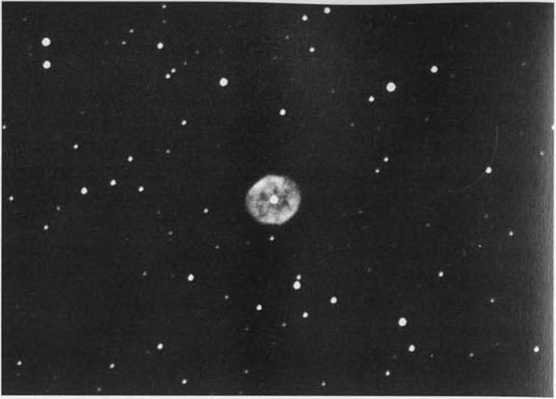

"The sky is always turning a new page," wrote Henry David Thoreau in his journal for November 17, 1837. Although he was referring to the daytime sky, with its perpetual random splendor of colors and clouds, one could argue that the same applies to the night sky. In a terrestrial sense it appears static, save for the nightly changes in perspective. Of course, there are new and marvelous sights that come to our attention, like a voyaging comet or an erupting nova or supernova. But deep-sky observers surprise us from time to time by finding some new asterism or shape in a grouping of stars. Such "discoveries" do little to advance astronomy as a science, just as seeing a pretty cloud adds little to weather studies. But they do add to the enjoyment of our hobby, and Scotty often opened our minds to the possibilities of such discoveries.
Despite more than a half century of peering into nooks and crannies and looking where the guide books were silent. I missed one of the sky’s more beautiful asterisms. In 1980 a letter from Lucian J. Kemble, who lives under the clean skies of Alberta, Canada, told of a fine grouping he had run across. While sweeping with 7 x 35 binoculars in Camelopardalis, Kemble found “a beautiful cascade of faint stars tumbling from the northwest down to the open cluster NGC 1502.” I called the asterism Kemble’s Cascade when writing about it in this column. The name has stuck. Although Kemble found the long star chain very remarkable, none of my references makes any mention of it. It was daylight when 1 read his letter, so all I could do was to look in Norton’s Star Atlas, but it showed no trace of the group. Other atlases proved blank as well. In fact, it wasn’t until the publication of the Uranometria 2000.0 star atlas in 1987 that Kemble’s group could be found on a map.
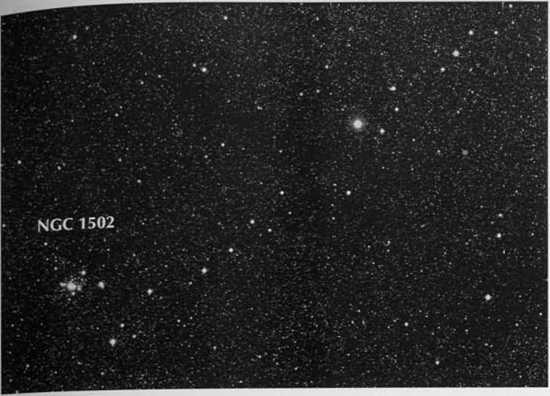
Figure 2.3
Kemble's Cascade in Camelopardalis is a long chain of stars near the open star cluster NGC 1502.
The asterism rides high in the northern sky during February evenings. I was shocked the night I first turned to the area with my binoculars, for there was a totally unexpected gem (Figure 2.3). In this pallid corner of Camelopardalis, tumbling steeply southeastward, was a celestial waterfall of dozens of 9th- and 10th-magnitude stars. Down it went, over 2/2° before splashing into NGC 1502.
Although seldom mentioned in observing guides, NGC 1502 stands out nicely from its relatively starless backdrop. Were it in a brighter part of the Milky Way, the cluster might be a problem, but many observers note that it stands out clearly. It has about 45 stars that shine with a total brightness of magnitude 5.7. They are pretty evenly spread across an 8' diameter and their magnitudes appear uniform. Binoculars or finders pick the cluster up easily. My 5-inch 20x spotting scope does an excellent job showing a score of 7th- to lOth-magnitude suns. Pat Brennan, an accomplished Canadian observer, draws the group as an obvious triangular mass, and other observers agree. It is often the case, however, that such shapes depend on the size and magnification of the telescope used for the observation. What do you see?
Tire cluster also includes two interesting multiple stars: Struve 484 and 485.* The former is a trio of lOth-magnitude stars with the companions separated from their primary by 5'1" and 221/2/'.The latter, however, is a small celestial fireworks display involving nine components, seven of which are between 7th and 13th magnitude and within reach of a good 4-inch telescope. Even the two 13.6- and 14.1-magni-tude components are accessible with an 8-inch telescope. Moreover, the system’s B component (brightest companion) is the eclipsing variable star SZ Camelopardalis, which dips 0.3 magnitude every 2.7 days.
Sfruve numbers refer to a list of double stars first compiled by the 19th-century astronomers Wilhelm Struve and his son Otto, from observations made at Dorpat and Pulkovo observatories in Russia.
Figure 2.4
The open cluster
Berkeley 10 is a 13th-magnitude cluster near Kemble's Cascade.
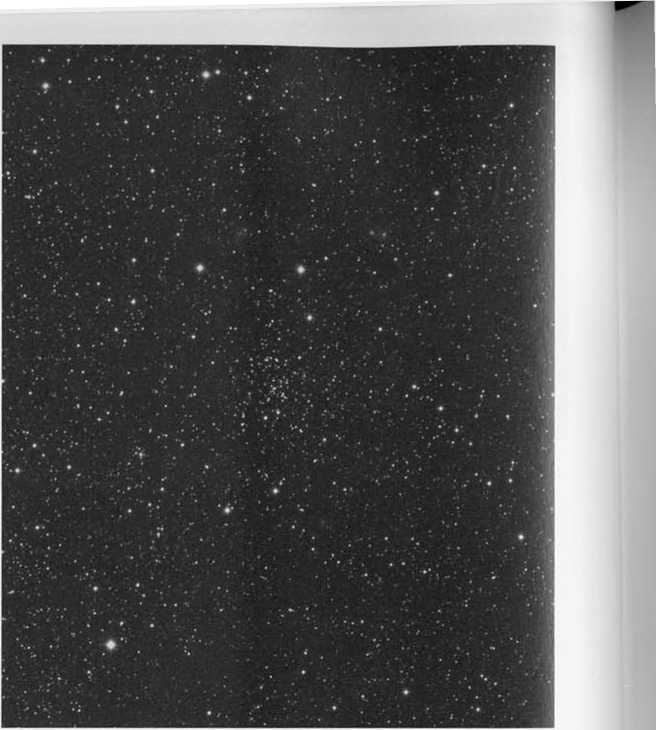
If you have a 16-inch or larger telescope try to see if you can detect the small open cluster Berkeley 10 (Figure 2.4). It is 3° north-northwest of the northern end of Kemble’s Cascade and is about 12' in diameter on the Uranometria 2000.0 charts. Some sources give it 50 stars or more, but none of the observing guides in my collection mentions this faint cluster whose brightest star is about 13th or 14th magnitude. I thought I could see it once with a friend’s 17-inch reflector, but the night was a smog brew that ruined the observation.
Another amateur discovery that came to my attention is Stock 23, on the border with Cassiopeia (Figure 2.5). It is a coarse collection of about 25 stars spread across 10' of sky, roughly magnitude 6.5, and visible in binoculars. What is particularly surprising is that the group carries no Messier, NGC, or IC designation. Sometimes it is referred to as Pazmino’s Cluster — after the New York amateur who wrote about his independent discovery of it in Sky & Telescope for March 1978. Stock 23 was virtually unknown in the late 1970s when John Pazmino accidentally stumbled across it while observing with a 4.3-inch refractor. I found an interesting comment about Stock 23 in the Deep-Sky Field Guide (the companion volume to the Uranometria 2000.0 star atlas). The guide mentions that Stock 73 is involved with nebulosity. I've not heard of this before, and none is visible from Connecticut in my 4-inch Clark refractor. Perhaps someone with a larger telescope and better skies can check this out.
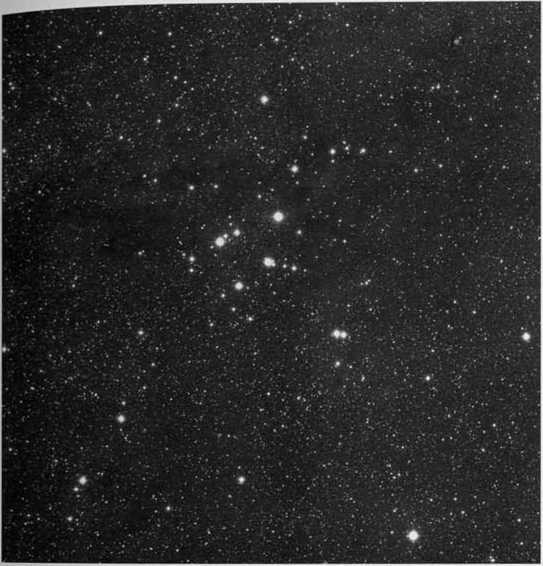
Figure 2.5 Look near the southeastern corner of Cassiopeia, just over the border in Camelopardalis, for the open cluster Stock 23. It is also known as Pazmino's Cluster.
By the way, Kemble uses a trick for making drawings at the telescope that I have not heard mentioned before. He racks the eyepiece out of focus until only the brightest stars are visible, and then plots their relative positions. Once this “skeleton" is made, he refocuses and adds the fainter stars.
In December 1981 Scotty pondered whether the California Nebula (NGC 1499) in Perseus could be seen with the naked eye, and he asked readers for their comments. "This large, faint, diffuse nebula," he wrote, "is plotted as an inviting green blob over 2° long on the new color edition of Wil Tirion's Sky Atlas 2000.0. However, I have never looked for it and do not have any letters in my file mention-lng visual sightings of it. ... I suspect that large binoculars, perhaps equipped with nebula filters, will have the best chance of revealing it." Of course, the positive responses poured in. Scotty had begun what was fast becoming the hottest new visual challenge for telescopic and naked-eye observers.
At the 1982 Texas Star Party, I was asked what was the best new challenging
L deep-sky object after the large-aperture Dobsonian revolution had dispatched most of the test objects from the 1950s and '60s. I suggested the California Nebula, not knowing that a piece of modern technology would soon remove it from the list of challenges: a skyglow-piercing nebula filter. In fact, I remember saying that it is the ultimate test object for visual observers. So much for that wisdom, for little did I realize when I made the comment that before I returned to Connecticut I would see the nebula with my naked eye through an O III filter. In the winter of 1992, in Mexico, the same filter showed the California Nebula as “bright.”
Figure 2.6
The California Nebula (NGC 1499) lies about 12° north of the Pleiades. This emission nebula is about 2,000 light-years away in the constellation Perseus.
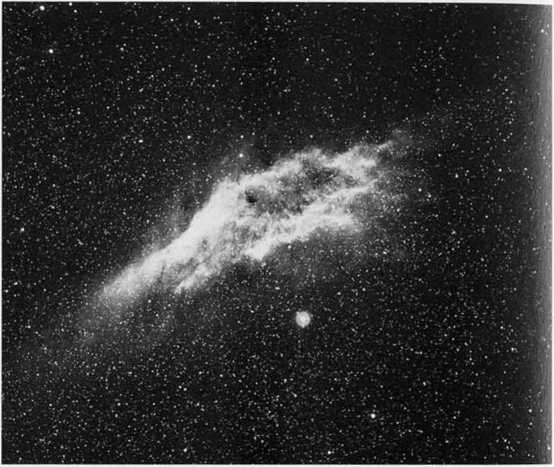
The California Nebula (Figure 2.6) is a vast cloud of glowing hydrogen (plus trace amounts of other gases) about 272° long and ’A® wide. It was discovered visually by E. E. Barnard on November 3,1885, while he was using the 6-inch refractor at Vanderbilt University in Nashville, Tennessee. It is known as the California Nebula because its shape, recorded on long-exposure photographs, is similar to that of the western state. NGC 1499 has a surface brightness which is less than that of M33. So conventional wisdom has long held that the surface brightness of the California Nebula is too low to be seen against the background sky visually in any telescope. Of course, the fact that Barnard discovered the nebula visually seems to have been long forgotten.
Today the term low surface brightness (LSB) is used to describe large, diffuse objects such as the California Nebula. Their surface brightnesses are so close to that of the sky background that the observer can run his or her eye across the edge of the object without realizing that the view has changed from sky to nebulosity. These objects are seen only when the sky is dark and transparent. A low magnification should be used so that the field of view shows plenty of sky to contrast with the object.The telescope’s optics should be well collimated and free from dust and jirt that would scatter light and reduce the image contrast. The eyepiece also hould be clean, and all air-to-glass surfaces antireflection-coated. While a number of things affect the visibility of LSB objects, I suspect that seeing them depends more on observer experience and eye training than on specific telescope f/ratios and magnifications.
Despite its difficulty. NGC 1499 has been viewed by a fair number of amateurs. John Bortle of Stormville, New York, did not have the best sky conditions when he observed the nebula. He writes: “NGC 1499 is visible, although extremely faint, in both 10 x 50 binoculars and 20 x 80 binoculars; the northern side of the nebula appears rather sharply defined even though the object’s entire outline is generally quite vague. The presence of Xi (£) Persei (4th magnitude and about 1° south of the nebula) is an annoyance and hinders observation. It is decidedly fainter in surface brightness than the nearby Merope Nebula in the Pleiades and much fainter than the North America Nebula. I imagine its visibility is limited to binoculars for want of contrast in narrow-field telescopes.”
Alister Ling of Montreal, Canada, also furnished a report on NGC 1499. He was observing from a small boat in the middle of a lake by David Levy’s cottage in northern Quebec. While this may seem rather unusual, the water acts as a thermal stabilizer and often provides better seeing conditions than on the nearby land. Ling comments: “I made a monocular from my 400-mm telephoto lens by attaching a 28-mm orthoscopic eyepiece to it.This gives a magnification of about 14x and a field several degrees in diameter. No sooner had I located Xi Persei than the extended nebula was quite obvious. It was about l'A0 long with two fairly bright stars embedded near its edge. Roughly at its midpoint there is an obvious kink in the nebulosity. It appears more like a mass of unresolved stars than a gas cloud — very much as the Milky Way appears to the naked eye. Later, a crescent Moon rose in Gemini and rendered the California Nebula invisible.”
During a trip to the West Coast I spoke with several amateurs who had seen NGC 1499 with telescopes as well as with binoculars.Their technique was to locate the edge of the cloud and follow it around. Here in Connecticut I have glimpsed NGC 1499 with 6 x 30 binoculars and can see it nicely with a 5-inch Apogee scope at 20x. However, my 4-inch Clark refractor will not reveal the faint glow.
As a tinal note, in response to my query about visual observations of the California Nebula, Lucian Kemble writes that he has seen parts of it with a Celestron 8. In September 1981, he notes: “I had a perfectly dark sky and decided to try my luck. With a Celestron 8 and orthoscopic eyepiece giving 74x, I was able to cover the entire object without detecting any variations in its uniform, very pale surface. As it spans an area much greater than my eyepiece field, the nebula had to be viewed by sweeping. Its outline appeared as a very slightly lighter patch of sky against the background blackness. It was much like tracing (be far wispy reaches of M31 or the edges of the Helix or Rosette Nebula.”
Thus, il appears that NGC 1499 is accessible to a wide range of instruments. The most important requirements for locating it are an experienced eye and clear, dark skies. If your observing conditions are good and you cannot detect the nebula, try practicing on the galaxy M33 in Triangulum, which has a considerably higher surface brightness. Careful cleaning of the optics, especially the eyepiece, can help improve the image contrast of a telescope. Another suggestion is to apply gentle heat to the optics, including the eyepiece, to remove subtle condensation. This rather unconventional practice has worked very well for me with both reflectors and refractors.
Scotty often talked about the Big Four of Perseus, a diverse assortment of deep-sky objects ranging from the easy (the Double Cluster) to the difficult (the California Nebula). In the middle he listed the pleasing open cluster M34 and the intriguing planetary nebula M76, the Little Dumbbell. M76 is often touted as being a difficult object to spot, but Scotty knew otherwise. He suspected that this belief was based more on perception than on reality — that M76 appears to be a difficult-to-find object because many published magnitudes suggest it is one. As Scotty explained, this simply is not the case. M76 is indeed a treasure worth the hunt.
In the clear, cold nights of winter, the dazzling constellation Perseus stretches its silvery fishhook high in the northern sky. The Milky Way narrows considerably in Perseus, being partly veiled by interstellar dust, and we are looking well away from the center of the galaxy, in Sagittarius. Star charts show that the open star clusters which abound in Cassiopeia and Auriga are noticeably fewer in Perseus. But the constellation does offer many objects that will reward the observer who braves the cold weather to observe them.
One object that everyone should enjoy is M76, an unusual planetary nebula on the edge of a dense part of the Milky Way (Figure 2.7). Often called the Little Dumbbell because it resembles the more-familiar Dumbbell Nebula (M27) in Vulpecula, to me it always looks more like a dog biscuit. The nebula has a reputation of being hard to find, so here’s how best to find it. Start with Phi (<j>) Persei. This star and a dimmer one just to the south form a pointer, with Phi at the head, that directs the observer to a diamond of faint stars, within which M76 is dimly perceptible.
Do not be misled by the photographic magnitude of 12.2 given in some catalogs, which makes it the faintest object in the Messier catalog. I believe that it is much brighter. If I try to defocus a 12th-magnitude star until the image spans 1' or 2' (about the size of M76), the star disappears. Yet I can see the planetary in the same telescope, indicating that the nebula is brighter. Sky Catalogue 2000.0 lists M76 as magnitude 11.5, nearly a magnitude brighter than older listings. My own estimate has it brighter still, perhaps 11.0, and a nebula filter helps to make it stand out in a less-than-perfect sky.
With a small aperture or in indifferent sky conditions, M76 shows only a dim rrcgular oval with ragged edges. But one night, with an 8-inch reflector in the hills north of the Golden Gate in San Francisco, M76 was a most exciting object. It appeared more than 2' by 1' (large for a planetary) and high magnifications brought out an intricate network of turbulent celestial clouds. At Stcllafane in
rjngfield, Vermont. M76 appeared as a marvelous object in George Scotten’s 12-inch f/5.7 Dobsonian reflector. The nebula seemed to float between us and the starry background, its edges appearing even more frayed than when smaller
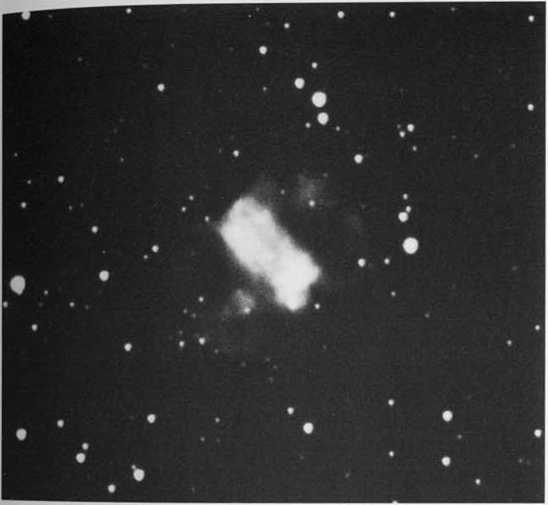
Figure 2.7
The Little Dumbbell (M76) lies more than 3,000 light-years away. It is sometimes referred to as the Cork Nebula or the Butterfly Nebula.
telescopes are used. Its curled twists and streamers seemed to show the whole mass in turmoil. At the 1992 Winter Star Party in the Florida Keys I had a chance to view M76 through the 36-inch Dobsonian reflector built by Tom and Jeannie Clark. To reach the eyepiece required climbing a stepladder half as high as the surrounding palm trees, but the view was worth it. It made anything I had ever seen in my old 10-inch reflector just a dusty memory.
Indeed, M76 has the oddest shape for a planetary nebula. Instead of the common smoke ring or circular disk, this nebula looks more like a brick about ~ long and half as wide. William Herschel thought it was two separate objects >n contact; therefore its disk has two NGC numbers — 650 and 651, the latter applying to the northeastern part. Ireland's Lord Rosse* thought he saw hints
m' 19th-century telescope maker and astronomer. Lord Rosse (William Parsons, 3rd Earl of Rosse) made umerous observations and discoveries with his fantastic reflectors, which he erected at Birr Castle. I lis o elescope, a 72-inch, was so enormous that it was nicknamed the Leviathan of Parsonstown. of a curious spiral structure. Since Rosse discovered the spiral structure of galaxies (known only as "nebulae” at the time), it’s easy to say that his interests influenced his view of M76. However, deep photographs do show circular arcs in the outer nebulosity surrounding M76, and these could have given the object a spiral appearance in Rosse's huge reflector. And W. H. Smyth used this planetan as a visibility test during a lunar eclipse on October 13, 1837. It was well seen during totality with his 6-inch, but gradually faded as the Moon came out of the Earth’s shadow. Some amateurs might like to repeat his experiment.
M76 is an emission nebula, and as such should be a good test object for lightpollution filters that are designed to transmit light from emission nebulae while blocking the skyglow from natural and artificial sources. A good plan would be to observe M76 on as many nights as possible over the next few months. Record the sky conditions on each night, and the nebula's appearance without the filter and then with it. It is important to look through the filter for several minutes to allow the eye time to adapt.
The night sky is full of undiscovered entertainers. Scotty reminded us time and again that there is more on the celestial stage than its primary players and often encouraged readers to take a good look at the sky's supporting cast. Often he would do this by tossing out an occasional "by-the-way." For example, in this section Scotty voices his concern about how an amateur is supposed to identify galaxies fainter than magnitude 13.5 — those not plotted on traditional star charts. Had he lived a few years longer, Scotty would have had a chance to congratulate Texas amateur Larry Mitchell, who compiled and plotted the positions of more than 27,350 anonymous galaxies. These galaxies now appear in Mitchell's Anonymous Catalogue, which is incorporated into the deep-sky database of the Megastar software package.
M34 in Perseus is an open cluster that receives relatively little amateur attention, because it is overshadowed by the more spectacular Double Cluster.
While not as rich, M34 (Figure 2.8) is one of the finest sights in wide-field telescopes that can be found. It lies about halfway between the stars Algol and Gamma (y) Andromedae, with a total brightness equal to that of a 5.2-magni-tude star. Messier discovered the cluster in 1764. Ten years later astronomer Johann Bode called it “a star cluster, visible to the naked eye.” W. H. Smyth found M34 a “scattered but elegant group.” Thomas W. Webb was more enthusiastic, exclaiming, “one of the finest objects of its class.”
According to Sky Catalogue 2000.0, nearly one-third of the Messier objects are brighter than the 6.5-magnitude limit often cited for the dark-adapted eye. However, brightness alone is not enough to determine the visibility of a given object — size also plays a very important role. For instance, I had a good view of M34 with
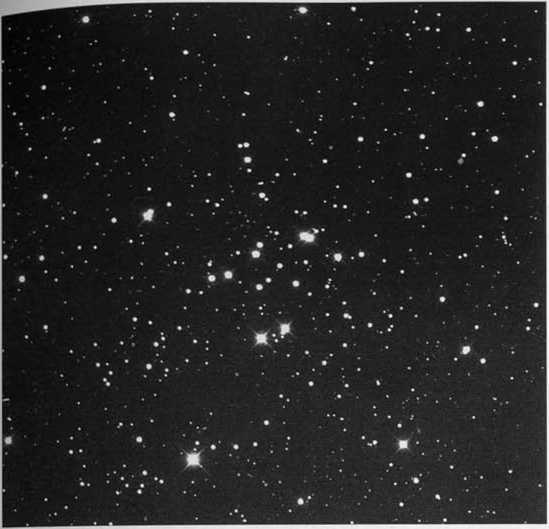
Figure 2.8 The bright open cluster
M34 is a fine sight in binoculars and small telescopes.
the Milwaukee Astronomical Society’s 13-inch reflector, when it appeared somewhat less than 30' in diameter, but this estimate was uncertain. Consider that Ake Wallenquist notes there are about 80 members brighter than 12th magnitude within an area 42' across. Why not try determining the size yourself?
Webb justly called attention to M34 as a grand, low-power, rich-field object. I feel that 15 x 65 binoculars give the best impression; the low power allows plenty of dark sky surrounding the cluster to enhance contrast. The sky background is sprinkled with faint stars, so it may be easier to decide where the cluster edge lies by using a small rather than a large telescope. More magnification merely spreads out the few bright stars that the binoculars show perfectly well.
Many observers see its stars arranged into distinct curved lanes that diverge from the cluster’s center. I see three noteworthy curved rays of stars running out from the center which are very evident in my 4-inch Clark refractor at 40x; indeed, they even show in binoculars. Many of the stars also form pairs, as mentioned by both Webb and Smyth. Near the center of the swarm lies the double star Otto Struve 44 (OZ 44), which my 4-inch refractor splits nicely at lOOx, especially when the heater is turned on to remove any trace of dew from the objective. The primary star is of magnitude 8.5 and the 9.2-magnitudc companion is 1-4 distant at position angle 55° (toward the northeast).
Digging Deeper
Until the late 1970s an unwritten rule prohibited amateur charts, observing handbooks, and columns like Deep-Sky Wonders from including objects fainter than about 13th magnitude.The reason was that big telescope mirrors were hard to come by because everyone followed the rule that a mirror’s thickness had to be one-sixth its diameter. Such mirrors larger than 12 inches cost a fortune. They are heavy, and a heavy mirror requires a heavy mounting with big castings and ball bearings.
There were exceptions. In 1932 I made a 10-inch reflector from '/’-inch plate glass. The mirror had to be carefully supported or else it made every star in the field appear double — pretty, but hardly suitable for astronomy.
In the early 1930s the Milwaukee Astronomical Society (MAS) received a 13-inch mirror from Cornell University. For a while it was the largest in the country solely dedicated to serious amateur observing. Ed Halbach made the mounting from welded steel plates and used brass bearings instead of expensive ball bearings. That mounting still serves the same telescope in the same MAS observatory, but at the time few telescope makers were eager to switch to the unconventional techniques that were used in its construction.
Go to any good-sized star party today and you'll find telescopes with an aperture of 20 inches or more. It’s now possible to break the 13th-magnitude limit. If you’re interested in trying, there’s a good starting point in Perseus. About 2'/?' west-northwest of the famous variable star Algol lie three little galaxies that all fit in the same eyepiece field. They form a nice north-south chain about 10' long. The northernmost galaxy, NGC 1130, at magnitude 13.0, is also the brightest. In the middle is NGC 1129, at magnitude 14.5, while at the southern end of the chain is 15.5-magnitude NGC 1131. They should ail show in a 10-inch scope under good skies.
None of the three is plotted on Tirion’s Sky Atlas 2000.0, but they are on the Uranometria 2000.0 charts. If you have a finder that shows 9th-magnitude stars, you can easily star-hop to the field by starting from Algol.
Let’s assume for the moment that you’ve hunted this group down with a 20-inch reflector. The scope should make easy work of the galactic trio, but what of the other galaxies in the field? There are a number of them here — ones not plotted on the Uranometria 2000.0 charts. Now what do you do, and for that matter are you still sure about the identifications of the first three? The answers are not simple. A Palomar Sky Survey print would certainly help in confirming what you see, but it would take some time at a major astronomy library to identify all the objects. Such are the problems confronting amateurs who push farther into the deep sky.
If this type of madness appeals to you, then try swinging to the unusual galaxy NGC 1275 (Figure 2.9), just over 2° east-northeast of Algol. The Herschels missed it, and we owe its discovery to the keen eyesight of H. L. d’Arrest. It was not considered anything special until astronomers in this century discovered it to be a strong radio source. Indeed, during the 1950’s Cliff Simpson and I operated an amateur 200-foot radio interferometer at Zeandale, Kansas. Although this “radio telescope" could not pinpoint objects in the sky, we did see a change in the signal as the general area of NGC 1275 passed across the beam of our
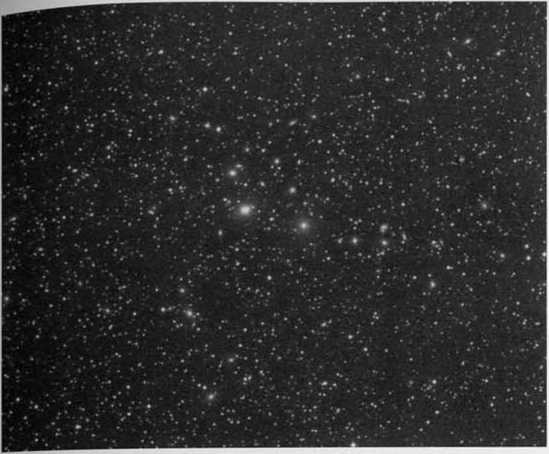
Figure 2.9
NGC 1275 (center) and galaxy cluster Abell 426. The core of NGC 1275 harbors the Perseus A radio source.
antenna. It was a much weaker signal than we recorded for the radio sources in Cygnus and Cassiopeia.
A look at the Uranometria 2000.0 chart for NGC 1275 shows the area swarming with galaxies. Identifying the individual members at the eyepiece would be near impossible even with this detailed chart. By good fortune, however, this is part of the cluster of galaxies known as Abell 426 (the Perseus Cluster) and included in Vol. 5 (Clusters of Galaxies) of the Webb Society Deep-Sky Observer’s Handbook. This work contains detailed finder charts for several dozen members of the cluster. How many you can see will depend on your telescope, observing skill, and the quality of your night sky. NGC 1275 itself has been reported in telescopes as small as 5-inch aperture. For large instruments, the Webb handbook notes that “the Perseus cluster presents probably the most spectacular concentrated galaxy field in the northern winter sky.”
Meandering across 1,138 square degrees of sky, Eridanus, the celestial River, is the sixth-largest constellation. Its northernmost stars stream out from brilliant Rigel in Orion's knee. From there, it brushes the celestial equator (nearly paralleling it at first) before dipping gradually southward to about -25°. From there the River plunges deep south in a double meander toward -57°, landing at 1st-magnitude Achernar. "This star is out of reach for all observers 'n *be United States," Scotty wrote in January 1972, "except in Florida, the Gull Coast, southern Texas, and Hawaii." In reality, many of the celestial wonders in Eridanus are within range of U. S. amateur telescopes — as long as the observer has a good southern horizon and a dark sky free of haze and pollutants.
As darkness settles on the February landscape, the mighty Hunter Orion stands high over the southern horizon. Now is a fine time, however, for observers living in northern temperate latitudes to explore the backwaters and eddies of the River Eridanus cascading westward from brilliant, blue-white Rigel. Eridanus meanders in graceful loops and bends before disappearing below the southern horizon, where it ends at Achernar deep in the southern sky, at declination -57°. Eridanus is an old constellation, but Achernar is a Johnnv-come-lately addition. The ancients who first outlined Eridanus could not see anything that far south. They originally considered the River’s end to be the star
Figure 2.10
The bright star Achernar in the constellation Eridanus.
|
• | ||
|
■ Achernar | ||
|
- ' o |
• | |
|
NGC 782 | ||
|
• • '' \ |
a Hydrae | |
Acamar, Theta (0) Eridani, some 16° north of Achernar. It wasn’t until explorers headed south that mappers extended Eridanus to Achernar, picking up (and corrupting) Acamar’s name.
Achernar is the ninth-brightest star in the sky (Figure 2.10). I once observed it from the slopes of a live volcano in southern Guatemala with a 4-inch rich-field reflector. Achernar was 10° high in a limpid sky and appeared as a terrific burst of sapphire light in the little telescope. I followed my usual practice after viewing an outstanding object of scouring several degrees of adjacent sky just to see what might be lost in the limelight of the showpiece. I found nothing. But back home in Connecticut, a glance at Uranometria 2000.0 revealed NGC 782 about 2'h0 east-southeast of Achernar. This is a 12th-magnitude spiral galaxy about 2' in diameter. I suspect it is fair game for 4-inch scopes and larger. It’s probably too low to be seen at the Winter Star Party, but considering some of the huge-aperture Dobsonian reflectors seen there in recent years, who knows?
Eridanus offers no star clusters — either galactic or globular — for average •itcur telescopes. Galaxies, however, swarm through it in abundance. So my target was a hard-to-see pair of galaxies in an easy-to-find field, about 1° orthwest of Upsilon4 (V*) Eridani. The brighter member is 1 lth-magnitude NGC 1532. At 20x, several minutes were required to glimpse this 5' x T spiral, but then it was held steadily. Its companion is NGC 1531, about 2' to the northwest Since this object is at least a magnitude fainter and only about 1' in diameter, 60x was required.
About 2° north ofTau4 (r4) Eridani is NGC 1300 (Figure 2.11). With a total light equivalent to a star of visual magnitude 10.3, NGC 1300 is a nice barred spiral galaxy seen almost face on. It is within reach of a 4-inch, and I have seen it easily even with a 3'/’-inch Questar telescope.Though photographs of NGC 1300 with large telescopes reveal a central bar with two thin but tightly wound spiral arms, small amateur instruments show only a blurred spindle. A 4-inch f/12 off-axis
|
• |
• |
Figure 2.11 The barred spiral galaxy NGC 1300. | |
|
• X • |
• | ||
|
• |
A* * |
4 |
reflector suggested some detail in the glow but fell short of showing any spiral structure. A 10-inch or larger telescope will give a more distinct image, about 6' x 3', and may even reveal the faint companion to the north, NGC 1297, which is 1 in diameter and magnitude 13. The smallest telescope in which I have sighted this neighbor is an 8-inch. Of course, a 17-inch, under the clear skies of the western United States, clearly showed NGC 1300 as a barred spiral full of wisps of nebulosity to explore.
Northwest ofTau4 Eridani and forming a right angle with it and Tau1 (t‘) is another gem — NGC 1232, which lies about 3° southwest of NGC 1300. Though its total visual magnitude is about 10, it appears much less conspicuous than a star of that brightness, as its light is spread over an area about 7' in diameter. The New General Catalogue describes this galaxy as "pretty bright, father large, round, gradually brighter in middle, mottled." It is a bit brighter and larger than NGC 1300, appearing nearly circular and about 7' in diameter. but I do not know of anyone seeing detailed structure with telescopes smaller than 12 inches. In my 4-inch refractor it seems to be better seen with a 15()x eyepiece than with a 50x used in combination with a 3x Barlow lens. This is curious, for usually a Barlow and a long-focus eyepiece give a view superior to an eyepiece of shorter focus that is used alone. Photographs show NGC 1232 as an open spiral.
If you’re interested in taking on a challenge, there is an interesting group around the lOth-magnitudc elliptical NGC 1332. NGC 1332 is about as bright as NGC 1300 and also visible in a 4-inch scope. It is a rather featureless elliptical galaxy with an oval disk about 4' long. Although there is no pronounced central brightening, the edges are distinctly fuzzy at 200x. Located less than 1° to the southwest is NGC 1325. an 11 th-magnitude spiral about 4' long and less than half as wide. A 13th-magnitude companion galaxy, NGC 1325A, is located just to the northeast. It is at the same declination as NGC 1332, 'l>° to its east. Several other galaxies in the immediate vicinity are all too faint for most amateur telescopes. Arizona amateur Ronald Morales did a fine job describing the NGC 1332 group in the February 1984 issue of Sky & Telescope.
Another spiral galaxy within the reach of a 4- or 6-inch telescope is NGC 1637. My 4-inch Clark refractor shows the galaxy at 34x, and though more difficult, the fixed 20x of my 5-inch Apogee scope also reveals it. This lone galaxy, which lies about 7' southeast of a 9th-magnitude star, is an 11 th-magnitude glow about 2' or 3' in diameter. It has been seen with a 3-inch by an observer who knew just where to look for it, but an 8-inch or larger is preferred. On photographs, NGC 1637 is revealed as an open Sc-type spiral.
Finally, here’s something to ponder. One of the weakest aspects of the NGC is the coded description for an object’s visual appearance. As an example, it describes the galaxy NGC 1440 in Eridanus as “pB, pS. R. smbM * 13,” which translates into “pretty bright, pretty small, round, smaller bright middle like a star of 13th-magnitude.” All this would be fine if we knew what telescope the observer used for the description. In some cases we know but in others it remains a mystery.
Averted vision is one trick of the amateur astronomer's trade that can benefit all skywatchers. Shifting your gaze slightly away from the object you're viewing makes use of peripheral vision by allowing you to peer deeper into the night, to see fainter objects, and to glimpse dim details that would otherwise go unnoticed with a direct gaze. Veteran amateur astronomers have learned how to position their eyes for optimum light-gathering power. It's all related to the eye's physiology, as Scotty explains below. He told beginning observers to practice first using averted vision without a telescope. For example, he advised those in a very dark sky to try to detect the faint outlying parts of the Milky Way. "Can you follow this glow
to M3L *he Andromeda Galaxy?" he asked. "Does the Milky Way fade undefinedly into the sky background, or does it have a more or less distinct edge?" Scotty understood that observing skills, like skills in any sport, are acquired through raining- He used his columns to coach observers on improving their visual acuity, to eke out finer details in all they observed.
As most observers are aware, away from the center of vision the retina is more sensitive to faint light. Thus, when one looks directly at a nebula, for example, its image falls near the center of the retina (fovea) — a region of high resolving power but rather low sensitivity. By looking a bit to one side, the image falls away from the center and on a usually more sensitive region. Thus, fainter images can be seen. The skilled observer always uses “averted vision” with faint objects. But the visibility of faint objects is very sensitive to the quality of the atmosphere, the individual’s eye, and experience. An observer must test each object because this method may aid some persons, while others do not find it particularly helpful.
The observer can experiment with various magnifications, averted vision, or a dark cloth to block stray light from entering the eye, to find which combinations work best for observing faint objects. Under conditions of low illumination, such as are frequently encountered in visual deep-sky observing, individuals differ greatly in retinal sensitivity. Some persons have large threshold gains, but others have very little. Also, the gain in red light is generally more than in blue.
In experiments at the Naval Research Laboratory in the late 1950s, one subject actually saw less as the image approached the edge of his retina. However, one exceptional individual’s sensitivity increased steadily in both colors; the gain in red light was three magnitudes in a direction 40° from the fovea. These experiments, by L. J. Boardman, were done with scotopic (dark-adapted) vision. Amateurs can test their own eyes (at least for point sources) by using an AAVSO chart to determine the limiting magnitude of stars visible with direct vision and with averted vision. The average of a dozen or so tries might tell you a good deal about your eyes.
Until the tyro observer acquires the skills needed to ferret out fainter deepsky targets, there is often a period of frustration at the eyepiece. Every year I receive a number of letters from persons who are facing this difficulty. My suggestion is to start with objects that are close to easily identified naked-eye stars. The telescope can be carefully moved from the star to the area to be searched. Then, confident that the nebula or cluster is within the field of view, the observer can experiment with averted vision and different magnifications to obtain the best view. In this hobby,a little experience goes a long way. You will quickly learn what techniques work best for hunting down the fainter objects.
As far as extended sources are concerned, planetary nebulae make good test objects. NGC 1535 is a good place to start (Figure 2.12). First, identify the field of NGC 1535, which swims through the darkness like a celestial jellyfish. Its 9th-magnitude oval disk is about '// long and surrounds a 12th-magnitude central star. However, a lack of bright guide stars in the area will make this dimly glowing patch of gas more of a challenge than its 20" diameter and magnitude suggest. The nearest guide star is 5th-magnitude 39 Eridani, about 2° due north.
But note that a few degrees west of NGC 1535 is conspicuous 3rd-magnitude Gamma (y) Eridani, which has a slightly curved chain of three 6th-magnitude stars north of it. The planetary is to the east at a distance about equal to the length of the chain. Since the finder’s field of view should be large enough to include all three stars of the chain, it is possible to point the telescope very near the nebula.
The planetary lies in a space about 1° in diameter containing no stars brighter than 9th magnitude. Look for that dark space with the finder, and center it.Then, through the main telescope, a low-power eyepiece (1° field) should show 8th-and 9th-magnitude stars only around the edge. In the middle there will appear a dim glow about 20" in diameter. A 6-inch or larger telescope may show some
fainter stars near the planetary. Once it is located, try higher powers; they often help with planetaries. This is when averted vision is particularly useful. Let your eye roam around the margin of the field but keep your attention on the center. Your eyes should be thoroughly dark adapted, and the more transparent the sky the better for these faint extended subjects.
Figure 2.12
The planetary nebula NCC 1535 in Eridanus.
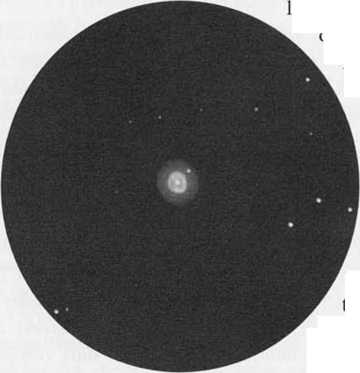
Telescopically, NGC 1535 has a pale, evenly illuminated disk, which W.
H. Smyth saw only like a star out of focus. His contemporary William Lassell. with a very large reflector, called it “most extraordinary.” Today, James Corn of Arizona reaches it without trouble. In the early days of spectroscopy William Huggins was perplexed by its “not gaseous”spectrum. but today we know that it and a few other planetaries have practically continuous spectra.
Two other planetary nebulae make good test objects. The first is PK 171-25.1 in Taurus. It is very difficult, being about 14th magnitude and only 40" in diameter. My 4-inch refractor failed to show it. but it was seen in a 12-inch. I had to use averted vision, which adds one or two magnitudes to my threshold.
The other, NGC 246, lies to the south in Cetus. Though its total light equals that of an 8th- or 9th-magnitude star, the surface brightness of this planetary is low because the light is spread out over an area about 4' across. Yet with averted vision I could see it in my 4-inch.
FEBRUARY OBJECTS
|
Nome |
Type |
Const. |
R.A. h m |
Dec. 0 / |
Millennium Star Atlas |
Uranometria 2000.0 |
Sky Atlas 2000.0 |
|
Achernor, Aloho («) Eridani |
♦ |
Eri |
01 37.7 |
-57 14 |
463, 478 |
418 |
24 |
|
Berkeley 10 |
OC |
Cam |
03 39.0 |
+66 31 |
31 |
18 |
— |
|
Californio Nebulo, NGC 1499 |
8N |
Per |
04 00.7 |
+36 37 |
117,118 |
95 |
4,5 |
|
IC342 |
Gx |
Cam |
03 46.8 |
+68 06 |
31 |
18 |
1 |
|
IC 3568 |
PN |
Cam |
12 32.9 |
+82 33 |
520 |
9 |
2 |
|
Kemble's Cascode |
Ast |
Cam |
03 56.0 |
+63 00 |
30,31, 43,44 |
18 |
1 |
|
little Dumbbell, M76, NGC 650-651 |
PN |
Per |
01 42.3 |
+51 34 |
63,82 |
37 |
1,4 |
|
M34, NGC 1039 |
OC |
Per |
02 42.0 |
+42 47 |
100 |
62 |
4 |
|
NGC246 |
PN |
Cet |
00 47.0 |
-11 53 |
316 |
261, 262 |
10 |
|
NGC782 |
Gx |
Eri |
01 57.8 |
-57 46 |
477 |
418 |
24 |
|
NGC 1129 |
Gx |
Per |
02 54.5 |
+41 35 |
99 |
63 |
— |
|
NGC 1130 |
Gx |
Per |
02 54.4 |
+41 37 |
99 |
63 |
— |
|
NGC 1131 |
Gx |
Per |
02 54.6 |
+41 34 |
99 |
63 |
— |
|
NGC1232 |
Gx |
Eri |
03 09.8 |
-20 35 |
333, 357 |
311 |
18 |
|
NGC 1275 |
Gx |
Per |
03 19.8 |
+41 31 |
98 |
63 |
4,5 |
|
NGC 1297 |
Gx |
Eri |
03 19.2 |
-19 06 |
332, 333 |
311 |
— |
|
NGC 1300 |
Gx |
Eri |
03 19.7 |
-19 25 |
332, 333 |
311 |
10,18 |
|
NGC1325 |
Gx |
Eri |
03 24.4 |
-21 33 |
332, 356 |
311,312 |
18 |
|
NGC 1325A |
Gx |
Eri 03 24.8 |
-21 20 |
332, 356 |
311,312 |
— | |
|
NGC 1332 |
Gx |
Eri |
03 26.3 |
-21 20 |
332, 356 |
311,312 |
18 |
|
NGC 1440 |
Gx |
Eri |
03 45.0 |
-18 16 |
331 |
312 |
10,11,18 |
|
NGC1501 |
PN |
Cam |
04 07.0 |
+60 55 |
43 |
18, 39 |
1 |
|
NGC 1502 |
OC |
Cam |
04 07.7 |
+62 20 |
30,43 |
18,19 |
1 |
|
_NGC1531 |
Gx |
Eri |
04 12.0 |
-32 51 |
377, 399 |
356 |
18,19 |
|
NGC 1532 |
Gx |
Eri |
04 12.1 |
-32 52 |
377, 399 |
356 |
18,19 |
|
_ NGC 1535 |
PN |
Eri |
04 14.2 |
-12 44 |
306 |
268 |
11 |
|
NGC 1569 |
Gx |
Cam |
04 30.8 |
+64 51 |
30 |
19 |
1 |
|
JfG£1637 |
Gx |
Eri |
04 41.5 |
-02 51 |
256,280 |
224 |
11 |
|
NGC 2403 |
Gx |
Cam |
07 36.9 |
+65 36 |
25 |
21 |
1 |
|
to = Asterism; BN = Bright Nebula; CGx = Cl LuC = 0pen Cluster; PN = Planetary Nebula;» |
uster of Galaxies; DN = Dark Nebulo; GC = Globular Cluster; Gx = C : = Star; * » = Double/Multiple Star; Var = Variable Star |
iolaxy; | |||||
FEBRUARY OBJECTS (CONTINUED)
|
Name |
Type |
Const. |
R. A. h m |
Dec. o / |
Millennium Star Atlas |
Uranometria 2000.0 | |
|
OX 44 |
♦ ♦ |
Per |
02 42.2 |
+42 42 |
— |
— |
— |
|
Pazmino's Cluster, Stock 23 |
OC |
Cam |
03 17.0 |
+60 00 |
45 |
18, 38 |
1 |
|
Perseus Cluster, Abell 426 |
CGx |
Per |
03 19.0 |
+41 30 |
98 |
63 |
— |
|
PK 171-25.1 |
PN |
Tau |
03 53.5 |
+19 28 |
187 |
132 |
4,10,11 |
|
Struve 484 |
♦♦ |
Cam |
04 07.4 |
+62 23 |
30,43 |
18,19 |
1 |
|
Struve 485 |
♦ * |
Cam |
04 07.9 |
+62 20 |
30,43 |
18,19 |
1 |
|
Whirlpool Galaxy, M51, NGC 5194 |
Gx |
CVn |
13 29.9 |
+47 12 |
589 |
76 |
7 |
Ast = Asterism; BN = Bright Nebula; CGx = Cluster of Galaxies; DN = Dork Nebulo; GC = Globular Cluster; Gx = Goloxy; OC = Open Cluster; PN = Planelory Nebulo;» = Star; * * - Double/Multiple Star; Var = Variable Star